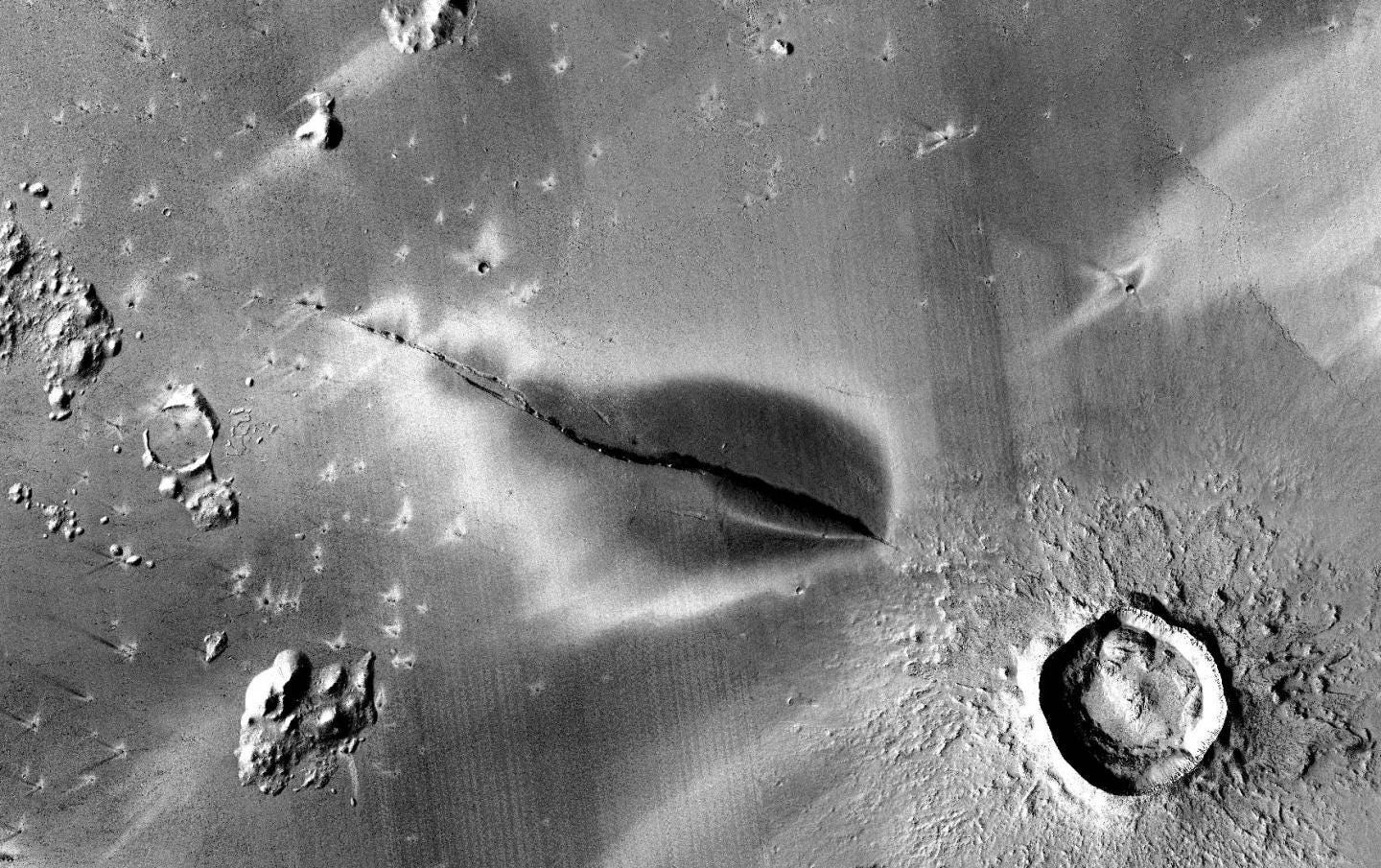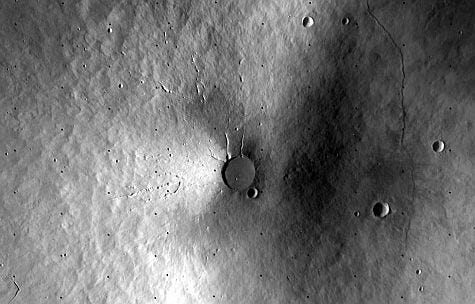Three to four billion years before our time, volcanoes erupted across the surface of the Red Planet. Smaller, more localized, eruptions continued until three million years ago. But, little evidence was found suggesting that volcanoes on Mars remain geologically active today. “Volcanic activity on Mars peaked during the Noachian and Hesperian periods but has continued since then in isolated locales. Elysium Planitia hosts numerous young, fissure-fed flood lavas with ages ranging from approximately 500 to 2.5 million years [ago],” researchers describe in a study published in the journal Icarus.
The plain truth about volcanoes on Mars
Strewn across Elysium Planitia near the equator of Mars, researchers recently found intriguing signs of far more-recent volcanic activity. This broad plain, which lies just south of the volcanic province of Elysium, includes several major volcanoes. Debris from a major eruption was seen spread across an area 32 kilometers (20 miles) long and almost 13 kilometers (eight miles) wide. “When we first noticed this deposit, we knew it was something special. The deposit was unlike anything else found in the region, or indeed on all of Mars, and more closely resembled features created by older volcanic eruptions on the Moon and Mercury,” explains Jeff Andrews-Hanna, associate professor at the UArizona Lunar and Planetary Laboratory. Most signs of volcanism on Mars appear to be the results of slow flows, similar to volcanoes in Iceland. A recent study has also shown similar active volcanoes on the surface of Venus. A look at the InSight Mission. Video credit: NASA/JPL-Caltech Further investigation revealed this debris field, however, is the result of a pyroclastic flow, driven by massive pressures underground. On Earth, pyroclastic flows may be best-known for burying the twin cities of Pompeii and Herculaneum in 79 CE. Evidence for these flows on Mars are usually centered around ancient eruptions which took place more than three billion years before our time. Olympus Mons — the largest mountain in the Solar System — was, long ago, once one of these ancient, behemoth Martian volcanoes. Gases within magma, pushed by geological pressures, may have directly led to this recent eruption, or — possibly — hot magma coming in contact with permafrost may have resulted in the fulminant release. “The ice melts to water, mixes with the magma and vaporizes, forcing a violent explosion of the mixture. When water mixes with magma, it’s like pouring gasoline on a fire,” Moitra said. This particular eruption may have lifted debris almost 10 kilometers (six miles) into the air — the height of Mt. Everest.
Some InSight into the subject
Mars may still see additional pyroclastic flows similar to the one that created the debris field examined in this study. NASA’s InSight lander, sitting 1,600 kilometers (1,000 miles) from the eruption, reports sensing two pairs of Marsquakes emanating from the Cerberus Fossae region since landing on Mars. “NASA’s InSight lander has detected two strong, clear quakes originating in a location of Mars called Cerberus Fossae — the same place where two strong quakes were seen earlier in the mission. The new quakes have magnitudes of 3.3 and 3.1; the previous quakes were magnitude 3.6 and 3.5. InSight has recorded over 500 quakes to date, but because of their clear signals, these are four of the best quake records for probing the interior of the planet,” NASA’s InSight mission team reports. The two pairs of quakes took place roughly one Martian year (two Earth years) apart. Both sets of readings were recorded during summer at the landing site. One possibility to explain this is that (despite shielding) winds might buffet the onboard seismometer, called the Seismic Experiment for Interior Structure (SEIS) during winter (when winds are higher), covering up tiny movements in the ground caused by Marsquakes. “It’s wonderful to once again observe marsquakes after a long period of recording wind noise. One Martian year on, we are now much faster at characterizing seismic activity on the Red Planet,” said John Clinton, a seismologist leading InSight’s Marsquake Service at ETH Zurich. Although Mars does not have tectonic plates like Earth, the Red Planet is home to volcanically-active regions which shake the surface. These are typically found in two forms — some are similar to those on Earth — traveling directly through the planet. Others are more Moon-like, taking place in scattered regions. All four Cerberus Fossae quakes were of the terrestrial variety. Exploring Mars with Dr. Fatima Ebrahimi and Dr. Kirsten Siebach. Video credit: The Cosmic Companion Researchers suggest this shaking could be due to magma moving under the surface of Mars. Prior to InSight landing on the surface of Mars, researchers suggested Marsquakes might occur within Cerberus Fossae. “This young age implies that if this deposit is volcanic then the Cerberus Fossae region may not be extinct and that Mars may still be volcanically active,” the study finds. Just 10 kilometers from the youngest impact crater on Mars — Zunil — sits the site of the youngest volcanic eruption seen on the Red Planet. Ages of the crater and the eruption appear to be identical, suggesting the asteroid impact may have triggered the volcanic eruption. Here on Earth, geologists have found evidence that large earthquakes can trigger volcanic eruptions. Water, heated and driven by subsurface magma, may have flooded the region as recently as 20 million years ago. This discovery could also hold implications for answering questions about life — past or present — on Mars. “The interaction of ascending magma and the icy substrate of this region could have provided favorable conditions for microbial life fairly recently and raises the possibility of extant life in this region,” David Horvath, research scientist at the Planetary Science Institute, said. Once thought to be a dead world, Mars seems to be showing signs of life — at least as far as the geologists are concerned. This article was originally published on The Cosmic Companion by James Maynard, founder and publisher of The Cosmic Companion. He is a New England native turned desert rat in Tucson, where he lives with his lovely wife, Nicole, and Max the Cat. You can read this original piece here.

